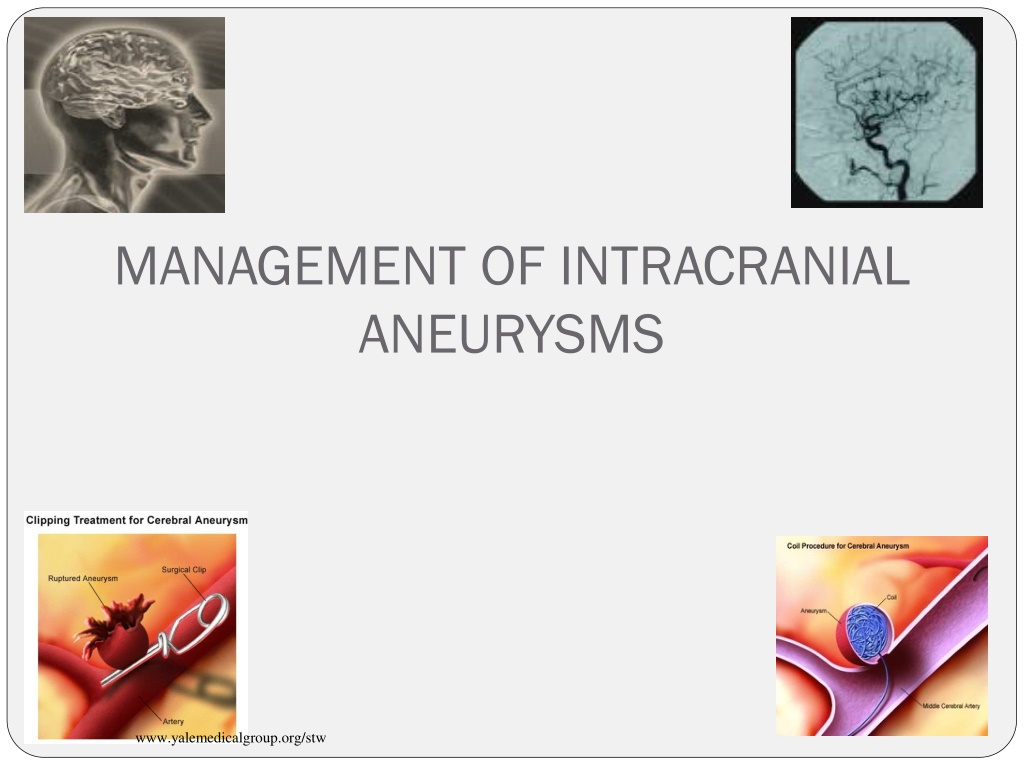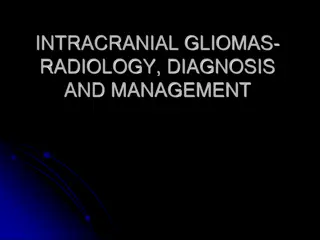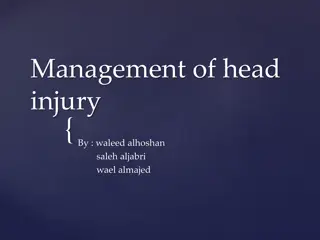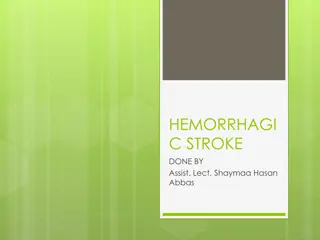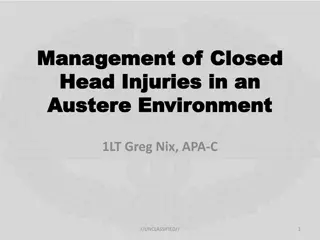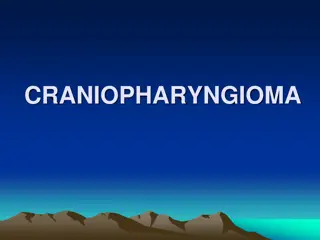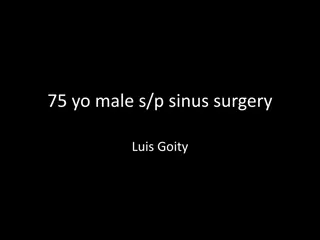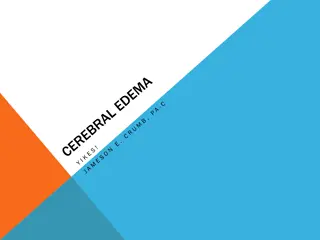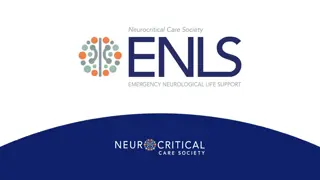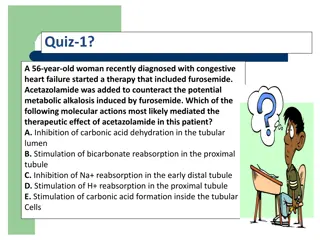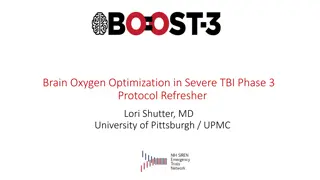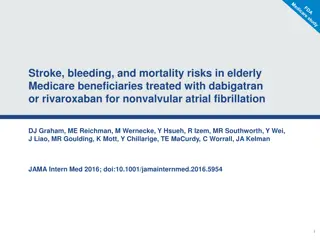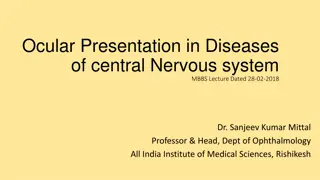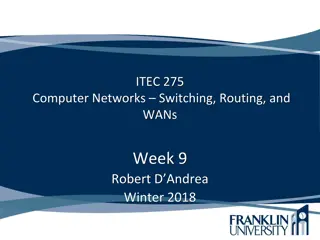Understanding the Management of Intracranial Aneurysms
This comprehensive guide explores the management of intracranial aneurysms, including incidence rates, mortality statistics, etiology, presentation, decision-making factors, and treatment options. It highlights the critical nature of timely intervention for ruptured aneurysms to prevent rebleeding and improve patient outcomes.
Uploaded on Oct 07, 2024 | 0 Views
Download Presentation

Please find below an Image/Link to download the presentation.
The content on the website is provided AS IS for your information and personal use only. It may not be sold, licensed, or shared on other websites without obtaining consent from the author. Download presentation by click this link. If you encounter any issues during the download, it is possible that the publisher has removed the file from their server.
E N D
Presentation Transcript
MANAGEMENT OF INTRACRANIAL ANEURYSMS www.yalemedicalgroup.org/stw
Introduction Incidence of aneurysm difficult to estimate Prevalence 0.2-7.9 % Half of the aneurysms ruptures The incidence of aneurysmal rupture is between 6 and 12 per 100,000. 2% present during childhood *van Gijn J, Rinkel GJ. Subarachnoid hemorrhage: diagnosis, causes and management. Brain 2001;124(Pt 2):249 78. Management of intracranial aneurysm
Introduction Overall mortality at 6 months: 40% - 50% 15% of patients expire before reaching the hospital 25% within 24 hours. Only one third of those who survive have functional independent lives. Hop JW, Rinkel GJ, Algra A, et al. Case-fatality rates and functional outcome after subarachnoid hemorrhage: a systematic review. Stroke 1997;28: 660 4. Rebleed has a catastrophic morbidity : 48% to 78%. Treatment of a ruptured aneurysm: imperative. Jane JA, Winn HR, Richardson AE. The natural history of intracranial aneurysms: rebleeding rates during the acute and long term period and implication for surgical management. Clin Neurosurg 1977; 24:176 84. Management of intracranial aneurysm Avijit Sarkari
Etiology of intracranial aneurysm Congenital Atherosclerotic/ hypertensive Embolic Infectious Traumatic Associated with other conditions Management of intracranial aneurysm Avijit Sarkari
Presentation Major rupture SAH ICH IVH Subdural blood Mass effect- cranial nerve palsy: 3rd nerve in PCOM Chiasmal syndrome - ophthalmic, Acom, Basilar top Cranial neuropathy- giant aneurysm compressing brainstem Endocrine disturbance: sellar and suprasellar Management of intracranial aneurysm Avijit Sarkari
Presentation Minor hemorrhage/sentinel hemorrhage Small infarcts Seizures Prodromal /warning/ sentinel headache: minor blood leakage or aneurysmal expansion- reported in 30-60% of SAH Few hours to a few months before the rupture- median of 2 weeks Due to sentinel leaks/ mass effect of aneurysm expansion/ emboli Incidentally discovered Management of intracranial aneurysm Avijit Sarkari
Decision making ? Mode of presentation Ruptured aneurysm Un-ruptured aneurysm Patients related factors General condition Medical co-morbidities Aneurysm related factors Location Anatomy Size Availability of expertise Surgical Endovascular Management of intracranial aneurysm Avijit Sarkari
Goals of aneurysm treatment Complete, permanent and safe occlusion of aneurysm. Less morbidity and mortality. Good quality of life. Management of intracranial aneurysm Avijit Sarkari
Un-ruptured aneurysms Importance of treatment 1. Risk of SAH is 0.05-6 % each year. 2. Around 50 % of these ruptures are fatal 3. Increase in size >1 cm increases the risk 11 fold (ISUIA trial. N Engl J Med 1998;339:1725-33) Management of intracranial aneurysm Avijit Sarkari
Risks factors for SAH in un-ruptured aneurysms Increased aneurysm size on serial imaging Aneurysm size > 10 mm Aneurysm between 6-9 mm in middle and young age group Posterior circulation aneurysms: especially basilar apex Previous SAH from another aneurysm Symptomatic aneurysms Females Cigarette smoking Binge alcohol drinking Management of intracranial aneurysm Avijit Sarkari
Factors affecting surgical outcome Aneurysm related factors Aneurysm size (>2.5 cm). Location (A-com, ICA bifurcation). Orientation Patient related factors Age Ischemic cerebro-vascular diseases Diabetes mellitus Management of intracranial aneurysm Avijit Sarkari
Options for definitive treatment Surgery. Clipping Wrapping Parent vessel occlusion Revascularization procedures Endovascular methods. Endoscopy Conservative Management of intracranial aneurysm Avijit Sarkari
Exclusive Indications for surgery SAH with ICH Hydrocephalus Signs of raised ICP Endovascular treatment is contraindicated Management of intracranial aneurysm Avijit Sarkari
Clipping : Indications The choice of open surgical intervention is influenced by several factors: ---complexity of the aneurysm, ---size (too small or too large), --- geometry, ---unfavorable dome-to-neck ratio, ---access (inability to navigate delivery system to aneurysm site), --- anatomy (parent artery, branch artery, or perforator incorporation into neck). Management of intracranial aneurysm Avijit Sarkari
Timing of surgery Anterior circulation: early surgery has good results Posterior circulations: Easy aneurysms: early surgery Difficult aneurysms : after two weeks (Haley EC jr et al the international cooperative study on the timing of aneurysm surgery; the north American experience. Stroke 23:205-214;1992) Management of intracranial aneurysm Avijit Sarkari
Early surgery: Advantages Virtually eliminates re-bleed Facilitates treatment of vasospasm Removal of vasospasmogenic material Though operative mortality higher, but overall outcome is better Factors favoring early surgery: Good medical condition Good neurologic condition Large clot, blood Early rebleed, multiple episodes Imminent rebleed signs Management of intracranial aneurysm Avijit Sarkari
Disadvantages of Early Surgery Inflammation and brain edema causes more difficult and traumatic retraction Acute clot makes dissection difficult Risk of intraoperative rupture is high Vessel injury may aggravate vasospasm Factors favoring late surgery: Poor medical and/or neurological condition Difficult aneurysms Significant edema on CT Active vasospasm Management of intracranial aneurysm Avijit Sarkari
Surgery :Technical considerations Intraoperative objectives Prevent rupture Further enlargement Preserve normal vessels Minimize injury to the brain Management of intracranial aneurysm Avijit Sarkari
Surgery :Technical considerations Clip too low- may occlude parent vessel Distal placement- aneurysmal rest Aneurysmal rest expand in future and may rebleed Surgical exposure: Avoid retraction Brain relaxation- hyperventilation, CSF drainage, lumbar spinal drainage, cisternal drainage Drugs Management of intracranial aneurysm Avijit Sarkari
Surgery :Technical considerations Intra operative aneurysm rupture- 18- 40% Morbidity and mortality approach 30- 35% When aneurysm can rupture Initial exposure- Reduce BP Temporary clip if possible Lobectomy if necessary for exposure Dissection of aneurysm- Blunt or sharp tears- tamponade, temporary clip If extends to parent vessel micro sutures may be taken Clip application- reapply clip or a second clip Management of intracranial aneurysm Avijit Sarkari
Surgical technique The cornerstone of open surgical management -- microsurgical dissection of the subarachnoid planes --proximal and distal vascular control --direct visualization of clip application -- puncture verification of total aneurysm obliteration. Yasargil MG, Fox JL. The microsurgical approach to intracranial aneurysms. Surg Neurol 1975;3:7 14. Management of intracranial aneurysm Avijit Sarkari
Advances in surgery Surgical innovations, such as cranial base approaches. Origitano TC, Anderson DE, Tarassoli Y, et al. Skull base approaches to complex cerebral aneurysms. Surg Neurol 1993;40:339 46. Intraoperative angiography: confirming parent or branch artery patency and aneurysm obliteration. Alexander TD, Macdonald RL, Weir B, et al. Intraoperative angiography in cerebral aneurysm surgery: a prospective study of 100 craniotomies. Neurosurgery 1996;39:10 7 [discussion: 17 8]. Origitano TC, Schwartz K, Anderson D, et al. Optimal clip application and intraoperative angiography for intracranial aneurysms. Surg Neurol 1999;51: 117 24 [discussion: 124 8]. Management of intracranial aneurysm Avijit Sarkari
Wrapping Indications Aneurysm cannot be clipped Intraoperative rupture Materials used Muscle Muslin Plastic resin or polymer Artificial glue and muscle Fascia Teflon Management of intracranial aneurysm Avijit Sarkari
Parent vessel ligation Indications: Large surgically difficult aneurysms Recurred after coiling Other unclipable aneurysms Prerequisite: Good collateral circulation on balloon occlusion test or cross compression test Methods of parent vessel ligation Direct neck vessel ligation Gradual occlusion: Silverstone clamp Management of intracranial aneurysm Avijit Sarkari
Revascularization procedures Indications: All those patients planned for ligation of parent vessel ligation but poor collateral circulation. Results: Good outcome 80% of anterior circulation 44% of posterior circulation Graft patency rate of 86% at 18 months Complications Acute graft occlusion Aneurysm rupture: d/t hemodynamic changes Ischemic deficits Management of intracranial aneurysm Avijit Sarkari
Endovascular methods Exclusive Indications: Poor grade SAH Medical illness Surgically difficult aneurysms eg: proximal ICA basilar top giant aneurysm Patients preference Management of intracranial aneurysm Avijit Sarkari
Endovascular methods Destructive procedures Balloon occlusion of parent vessel Reconstructive procedures GDC coils Balloon remolding technique Stent coil technique Management of intracranial aneurysm Avijit Sarkari
Balloon occlusion Generally used for proximal ICA and vertebro-basilar aneurysms Advantages Mass effect resolves Cranial neuropathies are known to improve Disadvantages: Recanalize, regrowth or rupture Ischemic symptoms Formation of de-novo aneurysms Management of intracranial aneurysm Avijit Sarkari
GDC coils Platinum spiral coils with circular memory Fit snugly in the aneurysm and induce thrombosis Disadvantages: Incomplete obliteration Recanalization Prolapse of coil and distal migration Parent artery thrombosis Management of intracranial aneurysm Avijit Sarkari
Balloon remolding technique Introduced to overcome the problem of wide neck aneurysms Balloon is inflated in parent vessel against the neck and then coils are put in sac Management of intracranial aneurysm Avijit Sarkari
Stent-coil technique Used in complex wide neck aneurysms Increases the density of coil packing Management of intracranial aneurysm Avijit Sarkari
Limiting factors of coiling Dome to neck ratio < 2 Neck width > 4 mm Inadequate endovascular access Unstable intraluminal thrombus Arterial branch incorporated in neck Middle cerebral artery aneurysms Management of intracranial aneurysm Avijit Sarkari
Endoscopy Endoscope (fiberscope) to assist the microsurgical clipping of cerebral aneurysm- first reported by Fischer and Mustafa in 1994 Rigid endoscope: structures around the aneurysm can be detected with high quality imaging Supportive role in planning surgical manoeuvres and verifying whether clipping has been performed correctly Aneurysms of anterior circulation- esp. those of ICA and Acom artery. Many have the posterior communicating artery, choroidal artery or one of the distal cerebral arteries hidden behind the aneurysm dome Management of intracranial aneurysm Avijit Sarkari
Special circumstances POOR GRADE SAH Rapid resuscitation Intracranial pressure monitoring Early aneurysm occlusion Prophylaxis against delayed ischemia Management of intracranial aneurysm Avijit Sarkari
Factors affecting outcome after definitive treatment 1. Diffuse SAH on NCCT head 2. Intraventricular bleed 3. Higher Fisher s Grade on NCCT head 4. Location of aneurysm (posterior circulation) 5. Rebleed before intervention 6. Post intervention infarct/hydrocephalus/meningitis 7. Acute renal failure 8. Septicemia A significant number of patients with poor grade SAH can have favorable outcome after aggressive definitive treatment. Patients who improve with resuscitation, merit intervention. Large craniotomy flaps / decompressive craniectomies are helpful in such patients. Ashish Suri,, Karanjit Singh Narang, B.S.Sharma. Department of Neurosurgery. AIIMS Avijit Sarkari
Advanced age ?? Surgically treated patients do better than conservatively managed. Treatment of unruptured aneurysm is beneficial if life expectancy is more than 13 years. Treatment should not be denied only on the basis of age. Management of intracranial aneurysm Avijit Sarkari
PREGNANCY ?? Investigated and treated as same. Pregnancy can be continued Temporary clips than hypotension during surgery Mannitol and hyperventilation to be curtailed LSCS is preferred in unruptured cases Craniotomy and LSCS performed together Anticonvulsants and CCB to be avoided. Management of intracranial aneurysm Avijit Sarkari
Infective aneurysms ?? Streptococcus is most common cause Course of IV antibiotics for 4-6 wks. Surgical excision of aneurysm followed by bypass, anastomosis, or ligation of vessel. Management of intracranial aneurysm Avijit Sarkari
Giant aneurysm Aneurysm >25 mm Mortality : 5-25% Good or excellent outcome in 70-80% Treatment options Clipping ( multiple clipping, fenestrated clips) Parent vessel ligation Revascularization with or without trapping Endovascular occlusion Management of intracranial aneurysm Avijit Sarkari
CLIPPING V/S COILING Management of intracranial aneurysm Avijit Sarkari
Clip vs coil: Safety Clipping the mortality rate 1% -3.8% the morbidity rate 4% - 12%. King JT Jr, Berlin JA, et al. Morbidity and mortality from elective surgery for asymptomatic, unruptured, intracranial aneurysms: a meta-analysis. J Neurosurg 1994;81(6):837 42. Coiling the mortality rate 0.5% - 2% the morbidity rate is 4% to 5%. Johnston SC, Dudley RA, et al. Surgical and endovascular treatment of unruptured cerebral aneurysms at university hospitals. Neurology 1999;52(9): 1799 805. Management of intracranial aneurysm Avijit Sarkari
Efficacy: Clip vs coil Clipping seems to be superior to coiling in achieving goals over the short and long term. Most series report a 92% to 96% exclusion rate of the aneurysm from the circulation with microsurgical clipping. David CA, Vishteh AG, et al. Late angiographic follow-up review of surgically treated aneurysms. J Neurosurg 1999;91(3):396 401. With respect to endovascular coiling, most series report 40% to 55% complete exclusion, 35.4% to 52% near-complete exclusion 3.5% to 8% incomplete exclusion of the aneurysms from the circulation. Murayama Y, Nien YL, et al. Guglielmi detachable coil embolization of cerebral aneurysms: 11 years experience. J Neurosurg 2003;98(5):959 66. Management of intracranial aneurysm Avijit Sarkari
Clip vs coil Patient factors : Age Morbidity and mortality rate in those patients undergoing surgical clipping. 6.5% for patients less than 45 years old, 14.4% for patients 45 to 65 years old, 32% for patients greater than 64 years old Unruptured intracranial aneurysms :risk of rupture and risks of surgical intervention. N Engl J Med 1998;339:1725 33. Similar finding have been reported with endovascular coiling, but the effects seem to be less significant with endovascular coiling in older patients. Barker FG II, Amin-Hanjani S, et al. Age-dependent differences in short-term outcome after surgical or endovascular treatment of unruptured intracranial aneurysms in the United States, 1996 2000. Neurosurgery 2004;54(1):18 28 [discussion: 28 30]. Management of intracranial aneurysm Avijit Sarkari
Clip vs coil Aneurysm factors : size Increased size : increased risk with microsurgical treatment. Wirth et al : linear relation with regard to size and complication rate 3% for aneurysms less than 5 mm 7% for 6- to 15-mm aneurysms 14% for aneurysms of 16 to 24 mm. Wirth FP, Laws ER Jr, et al. Surgical treatment of incidental intracranial aneurysms. Neurosurgery 1983;12(5):507 11. Endovascular treatment : extremely large and small aneurysms having increased complications. Extremely small aneurysms : risk of intraprocedural rupture . Giant aneurysms: less favorable dome/neck ratio, Higher incidence of a branch vessel origin of the aneurysm neck, Often intra-aneurysmal thrombus. Management of intracranial aneurysm Avijit Sarkari
Clip vs coil Aneurysm configuration Surgical complexity is increased Wide-necked Involving major neighboring artery : ensure complete exclusion of the aneurysm with preservation of the parent vessel and its associated branches. The most important factor :dome /neck ratio: large, intermediate, and small -the most favorable to least favorable configuration. Dense packing of the coils achieved with less risk of migration into the parent artery : small dome size, a small neck, and a large d/n ratio, (ideal for complete occlusion with fewer complications) Management of intracranial aneurysm Avijit Sarkari
Clip vs coil : Aneurysm location Posterior circulation aneurysms: higher complication rate with microsurgical treatment, most undergo endovascular therapy. Raaymakers TW, Rinkel GJ, et al. Mortality and morbidity of surgery for unruptured intracranial aneurysms: a meta-analysis. Stroke 1998;29(8): 1531 8. MCA aneurysms: often originate from one or both of the branching vessels often have an associated unfavorable d/n ratio. renders aneurysms unable to be coiled or migration of the coil into the parent vessel or a branch, resulting in a stroke. Clipping is still the most safe for most MCA aneurysms. Regli L, Uske A, et al. Endovascular coil placement compared with surgical clipping for the treatment of unruptured middle cerebral artery aneurysms: a consecutive series. J Neurosurg 1999;90(6):1025 30. Management of intracranial aneurysm Avijit Sarkari
Clip vs coil Management: UA The advantage of clipping: effective in changing the natural history of UIA in the short and long term. The disadvantage of clipping: risk of treatment is higher than that of coiling. The advantage of coiling: less invasive and safer than clipping, The major limitation: lack of durability in changing the natural history compared with clipping. Management of intracranial aneurysm Avijit Sarkari
Clip vs coil Management: UA Anterior circulation aneurysms with a large d/n ratio, endovascular coiling should always be considered as the first line of treatment in those patients with long, intermediate, and short estimated life expectancies, because this treatment provides the patient with relatively effective treatment that is safer than clipping. Posterior circulation aneurysms: patients with large and medium d/n ratios should undergo endovascular coiling regardless of the estimated life expectancy, because endovascular coiling provides a safer treatment that is relatively effective In some posterior circulation aneurysms with less favorable configurations, where the aneurysm sac involves one of the posterior cerebral branches, clipping may be the only alternative. Management of intracranial aneurysm Avijit Sarkari
International Study of Unruptured Intracranial Aneurysms (ISUIA) 1998 report: retrospective data controversial- 0.05% yearly rupture rate identified for aneurysms <10 mm : considerably lower than the rate in earlier reports If true, the risks of treatment higher than the natural history risk. ISUIA: New prospective data Lancet 362:103-110, 2003: results associated with endovascular or microsurgical repair. Management of intracranial aneurysm Avijit Sarkari
ISUIA Patients in Group 2 (Patients who have had a ruptured aneurysm at another location that was isolated, trapped, clipped, or treated through endovascular obliteration) with unruptured intracranial aneurysms less than 7 mm had higher rupture rates than did those in Group 1 (p<0.0001). For both Group 1 and Group 2 patients the combined morbidity and mortality at 1 year was about 3% higher in the microsurgical group (12.6% for clipping vs. 9.8% for coiling in Group 1 patients and 10.1% vs. 7.1% in Group 2 patients). Management of intracranial aneurysm Avijit Sarkari
